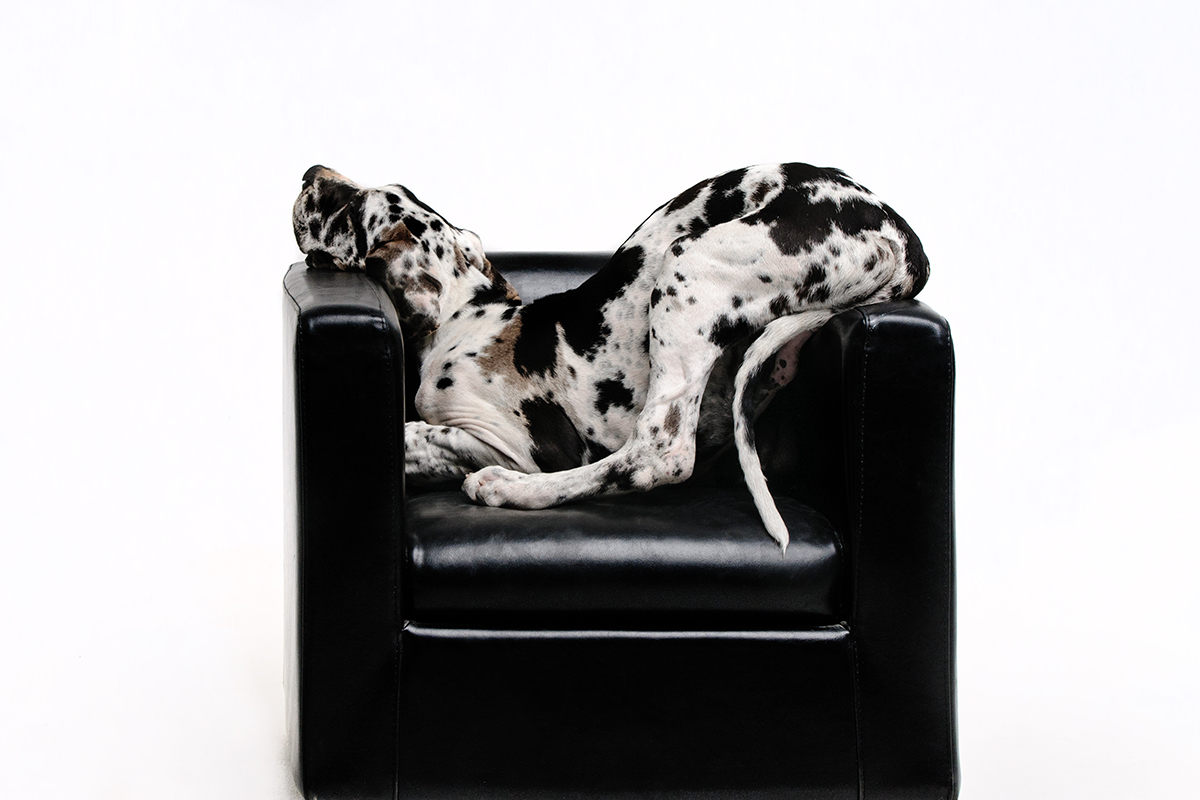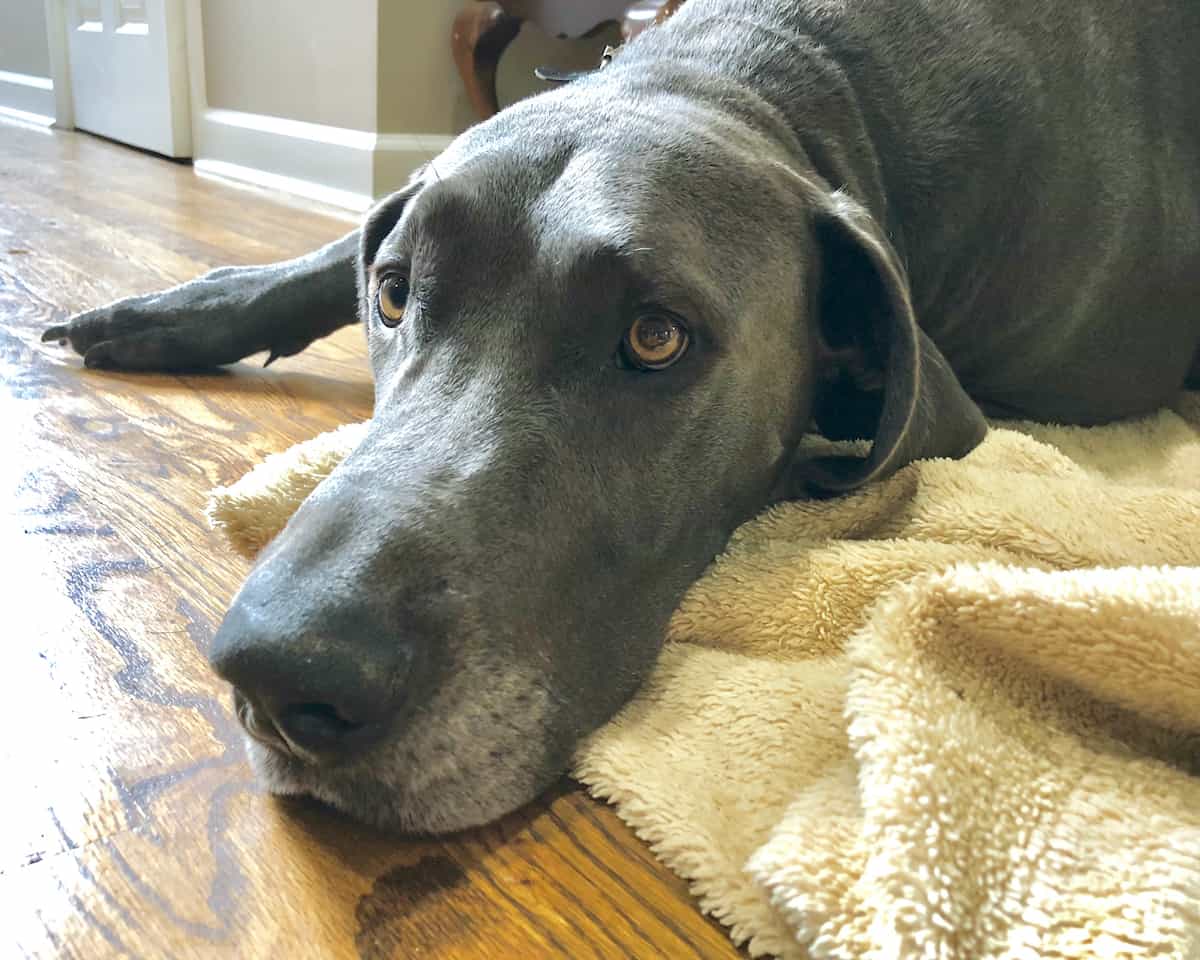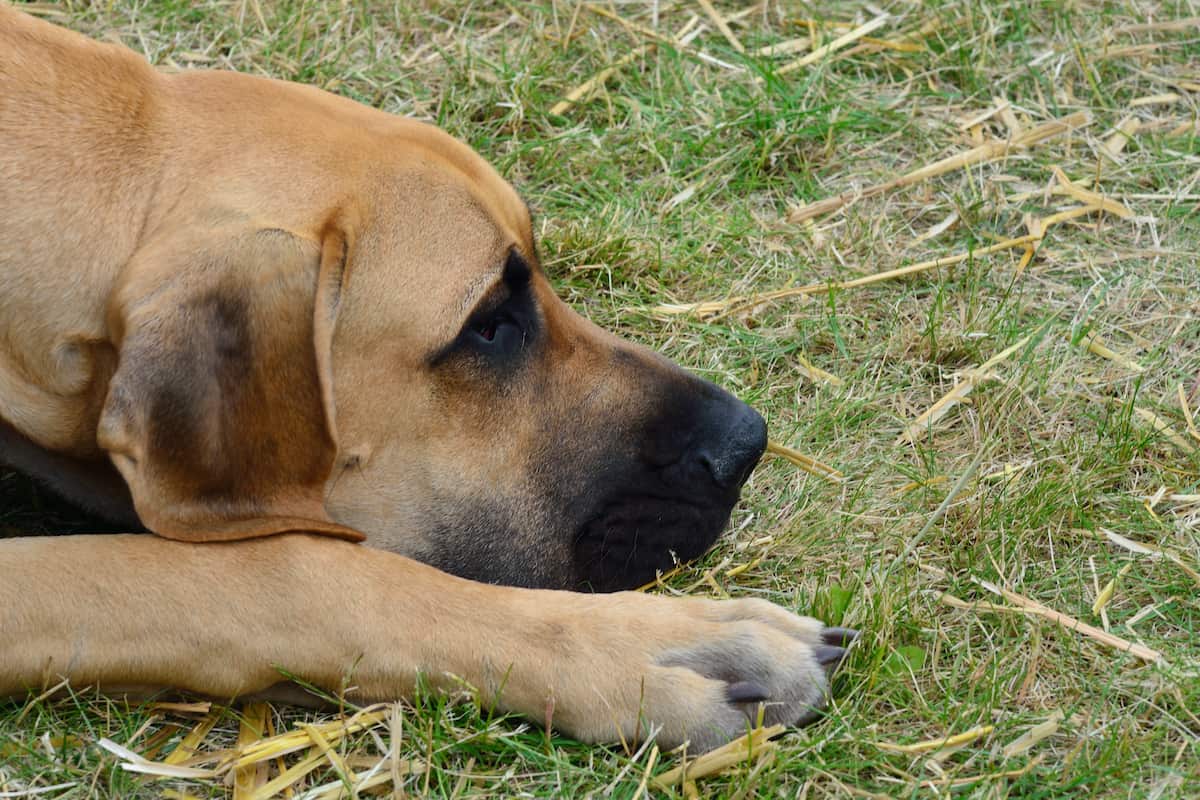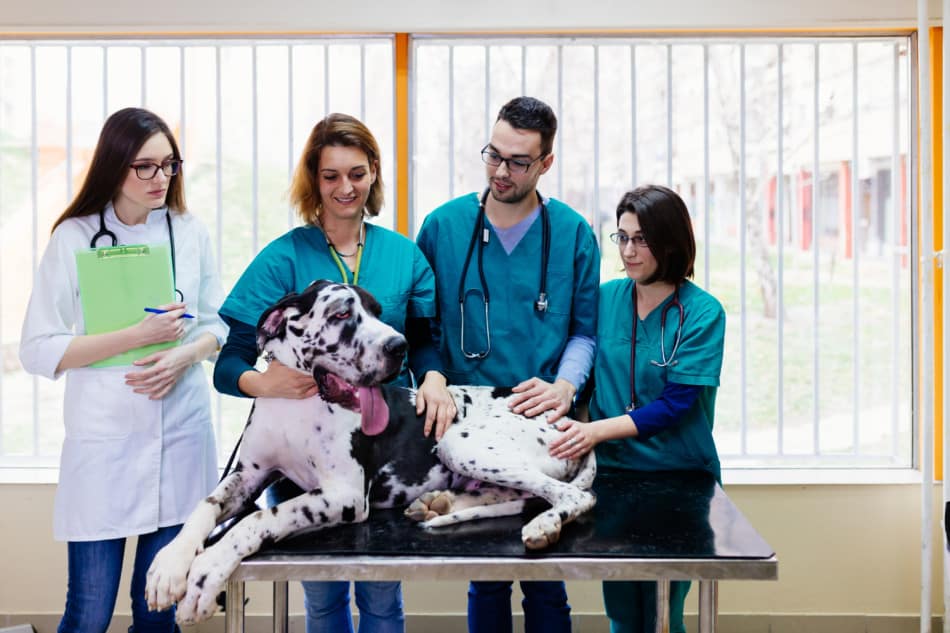
Has your Great Dane been diagnosed with megaesophagus recently, or are they constantly vomiting or regurgitating food? Has an internet search has led you to worry about megaesophagus in your Great Dane?
This disease may have sounded very scary and potentially life-threatening at first, but many Great Dane’s are able to live a reasonably normal and happy life while managing their disease. Sometimes the treatment is just to manage the side effect of this disease with daily lifestyle modifications.
With that, let’s dig in to get a better understanding of what megaesophagus is, how it occurs, and the methods for treating it in Great Danes!
What is Megaesophagus?
The esophagus is the organ that carries food from your Great Dane’s mouth to their stomach. This is a long slender tube made up of muscle.
There are many different things that can cause this tube to become dilated and enlarged.
When the esophagus is wider than it is supposed to be, your Great Dane may have a condition called megaesophagus.
Great Danes who have megaesophagus will have trouble swallowing their food. This food will usually end up getting stuck in the dilated part of the esophagus, which can cause your Great Dane to constantly regurgitate their food.
Sometimes this regurgitation can lead to aspiration pneumonia.
What causes megaesophagus in Great Danes?

There are many different diseases or genetic problems that can cause your Great Danes to have megaesophagus.
These different causes can be broken down into two main categories of megaesophagus that I’ll cover below.
Congenital Megaesophagus
If your Great Danes has congenital megaesophagus, this means that they are born with a problem that is causing the megaesophagus. You may first start to see problems with congenital megaesophagus shortly after the puppy is weaned.
When your Great Dane is starting to eat solid foods, you may notice that they are regurgitating its food or having trouble swallowing.
The cause of congenital megaesophagus in Great Danes is usually unknown but there are a few things that can cause these issues such as:
- A heart defect called a persistent right aortic arch (PRAA)
- Incomplete development of nerves
Persistent Right Aortic Arch (PRAA) is caused by a remnant of a fetal vessel that should not be present by birth. During the development of the heart, this vessel goes away.
If it does not develop properly and this vessel remains, it can cause a stricture or strangulation around the esophagus. This will cause the part of the esophagus that is closer to the mouth to become enlarged.
PRAA can be fixed with surgery by a veterinary cardiologist. Usually, this surgery must be done at a specialty hospital and is usually very expensive.
Even though there is a surgical procedure to fix the problem with the heart, the damage to the esophagus may be permanent.
Acquired Megaesophagus
Acquired Megaesophagus means that your Great Danes have acquired this later in life and were not born with this issue. Many times, the cause of acquired Megaesophagus is unknown.
There are a few diseases that can cause your Great Dane to have megaesophagus. These diseases include:
- Trauma to the brain or spinal cord
- Toxin Exposure
- Addison’s Disease
- Nerve or muscle disfunction
- Hypothyroid
- Foreign Object stuck in the esophagus
- Tumor in chest
If your Great Dane has acquired megaesophagus later in life, these are more likely to be corrected if you start treatment for the other disease early.
If your Great Dane shows signs of megaesophagus, it is best to see a vet as soon as possible. As early treatment can potentially cure your dog of megaesophagus.
Common symptoms associated with megaesophagus

There are many signs that are associated with megaesophagus in Great Danes. The most common sign that is associated with megaesophagus is regurgitation.
Regurgitation is very similar to vomiting, but your Great Dane will just spit up their food after eating. There will not be any retching. If your Great Dane is retching, then this would be vomiting and not usually associated with megaesophagus.
If your Great Dane does regurgitate, they are more like to develop aspiration pneumonia. Aspiration pneumonia is a very common issue that dogs who have megaesophagus can also have.
Other Signs Associated with Megaesophagus
Other signs that you may see in your Great Dane with megaesophagus are:
- Vomiting
- Coughing
- Discharge from their nose
- Weight loss
- Increased breath sounds
- Drooling
- Loss of appetite
- Bad breath
- Not gaining weight
If you notice any of these signs in your Great Dane, especially regurgitation, make an appointment with your vet. You can discuss the signs that you are seeing in your Great Dane and any concerns you may have with your dog having megaesophagus with your vet.
Your vet will want to run tests and take x-rays to help diagnose the cause of these problems. This will also make sure that your Great Dane does not have any other problems.
How do you diagnose megaesophagus in a Great Dane?

The good news is that megaesophagus can be easily diagnosed with x-rays at your vet’s office! Your vet will want to take an x-ray of your Great Dane’s chest and see if there is an enlarged esophagus.
It may be harder to make a definitive diagnosis of megaesophagus with just a plain x-ray, and your vet may want to run other tests. Many times, your vet can give your dog barium to drink. Barium is a white liquid that will show up on x-rays and help your vet diagnose megaesophagus.
When your vet takes an x-ray after your Great Dane drinks barium, this will help your vet see the outline of your Great Danes’ esophagus easier. Then making a definitive diagnosis of megaesophagus will be easier to make.
There are not any blood tests that can be run to diagnose megaesophagus, but there are blood tests to help figure out what may be the cause of megaesophagus in your Great Dane. These other tests will test for things such as hypothyroid, Addison’s disease, Myasthenia gravis.
There are also other tests that your veterinarian may want to perform are endoscopy of the esophagus to look for any defects inside the esophagus. They may also want to take a nerve or muscle biopsy or test of the cerebrospinal fluids (CSF) around the spinal cord.
All of these tests will help your vet potentially find the cause of their megaesophagus.
What is the treatment for megaesophagus in Great Danes?
The treatment for megaesophagus would all depend on what is causing megaesophagus in your Great Dane. Sometimes surgery can help if there is an obstruction in your Great Danes esophagus or a Persistent Right Aortic Arch.
There are some medications that can help treat any disease that may be causing megaesophagus. Some Great Danes will need to be started on medication to help keep their stomach empty or medication to help decrease gastric acid production, which can lead to other issues.
There are feeding modifications that you can do to help your Great Dane live with megaesophagus. It is recommended for Great Danes with megaesophagus to be fed a liquid gruel or small meatballs.
This will help prevent your dog from aspirating on its food. If your Great Dane has developed aspiration pneumonia due to their megaesophagus, your Great Dane may need oxygen therapy, antibiotics, or some other medications to help them recover from its pneumonia.
Depending on the severity of the megaesophagus that your Great Dane has, they may need a feed tube so that they can eat without aspirating on their food. A feeding tube would be a tube that would come out of their neck and goes all the way to their stomach.
This would help food bypass the esophagus so that your dog would not aspirate. Your Great Dane can even live with a feeding tube for years. These feeding tubes can be easily maintained at home, and your vet can show you how to properly feed your Great Dane.
Some dogs need to sleep with their head elevated so that food stays in their stomach. Often these dogs will have a balloon-type collar that they will wear to keep their head elevated.
How to manage and live with megaesophagus in Great Danes
There are many lifestyle modifications that you can do to help manage your Great Danes with megaesophagus.
- Elevated Bowls: Feeding your Great Dane from an elevated bowl will help food to go down their esophagus into their stomach much easier. It is best to raise their bowls to a height so that your Great Dane is eating at a 45 to 90-degree angle. You can easily find elevated dog food and water bowls. These are a great option for raised food bowls. These come in different colors and can be raised to 12 inches, which is great for your Great Dane. Even putting food bowls on boxes or making your own stand for them will help them eat much easier
- Slow Feeder Bowl: Some Great Danes with megaesophagus will eat their food very fast. This will cause food to get stuck in the enlarged part of their esophagus. By using a slow feeder bowl, will help make your Great Dane eat slower. This gives the food more time to get to their stomach.
- Bailey Chair. This is a feeding chair for your Great Dane. Your Great Dane would have to eat while standing or sitting on their back legs with their front legs resting on a ledge. This would be similar to a high chair for your dog. This posture, while eating, would cause gravity to help move food quickly and easily through the esophagus and into their stomach.
- Elevate after eating. After your Great Dane eats, it is best to hold its front legs up for about 10 to 15 minutes. This allows gravity to help move food from your dog’s mouth and into their stomach. Not all people can hold their Great Dane up that long and have trained their Great Dane’s to sit in the upright position with their feet on the couch or a bed after eating.
- Frequent Vet Visits: If your Great Dane does have megaesophagus, make sure to take them for regular vet checkups. This will help you assure that they are happy and healthy. Your vet can assess your Great Dane’s progress, adjust medication, or give other recommendations depending on the signs and symptoms that they are displaying at that time.
What is the prognosis of megaesophagus in Great Danes?
Great Danes who have megaesophagus will need lifelong management and therapy. This can be a very big commitment that pet owners must commit to each day.
The prognosis for megaesophagus in Great Danes can be good if the cause is determined, and the condition is treatable. However, this disease carries a poor prognosis most of the time since the underlying issue is usually unknown.
There are also many complications that can occur if your Great Dane has megaesophagus that also have a poor prognosis. Things such as malnutrition and aspiration pneumonia are commonly seen with megaesophagus and are the main causes of death.
With the help of your regular veterinarian, you may be able to have a diagnosis of the underlying cause of megaesophagus in your Great Dane if you have a commitment to the daily care and treatment of your Great Dane this will help your Great Dane to live a somewhat normal life and deal with megaesophagus.
Can a Great Dane grow out of megaesophagus?
While some Great Dane’s can grow out of megaesophagus, this is very rare. Most dogs who are diagnosed with megaesophagus have this their whole life.
Most dogs can live a pretty normal life. Most will usually die of some other condition if they are managed properly. Bailey, the dog that the Bailey chair was named after, lived 13 years and eventually died of lung cancer.
It wasn’t even the megaesophagus that got her in the end!
So even if your Great Dane does not grow out of this disease there are many people who are successfully managing their dog with this condition.
Final Thoughts on Megaesophagus
While megaesophagus may not be the best disease that you could hope for in your Great Dane, there are many lifestyle modifications that you can do to help your Great Dane live a healthy, normal, and happy life.
Things such as elevated feedings and slowing down when eating can allow your dog to have a long and happy life. Megaesophagus is a disease that can usually be successfully managed in many Great Danes.
If your Great Dane does have megaesophagus, you can work with your vet on a successful modification to allow your Great Dane to remain happy and healthy.

